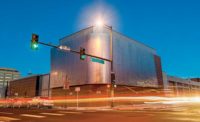Riazzi Substation
Pittsburgh
BEST PROJECT, ENERGY/INDUSTRIAL
Submitted By: Burns & McDonnell
Owner Duquesne Light Co.
Lead Designer | General Contractor Burns & McDonnell
Architect Perfido Weiskopf Wagstaff & Goettel
Subcontractors Mascaro Construction Co. LP; J.W. Didado Electric LLC; USi; Siemens Energy
The project team was hired to build a 138/23-kV gas-insulated substation and associated infrastructure in the heart of Pittsburgh for electric utility Duquesne Light.
It was a much-needed upgrade, considering that area residents and facilities, including the University of Pittsburgh and Carnegie Mellon University, are placing new demands on distribution systems.
Expanding campuses, new companies moving to town and the building of research and development facilities that use robotics and other power-draining technology all contributed to the need for more electricity.
The half-acre project site has a long rectangular footprint between the two campuses, a configuration that created complications for coordinating work crews.

Photo by Mary Tinitigan, courtesy of Burns & McDonnell
Tight schedule requirements worsened the issue by requiring multiple scopes to be completed concurrently.
Ultimately, more than 40 subcontractors managed to share the work space and finish their work on time in 24 months.
The project team also focused on supporting the local economy by hiring a construction workforce drawn primarily from Pittsburgh and southwestern Pennsylvania.
With more than 100,000 worker-hours completed on the job with zero recordable incidents, the team says it successfully applied its driving principle of “safety first.”
To mitigate confusion amidst a clutter of work, people, equipment and materials, the team implemented a required common start time, daily organizational meetings, daily walk-through inspections and sharing of equipment among subcontractors to eliminate duplicate items and tasks on site.

Photo by Mary Tinitigan, courtesy of Burns & McDonnell
Staffing and availability of material resources were among the project’s larger challenges. When lead times and materials prices began escalating rapidly, the owner and contractors worked to find items that were in stock or sought alternative sourcing.
When a commissioning engineer for a key piece of equipment was stuck abroad, the owner contacted federal officials in Washington, D.C., for help with approvals.
Team members say the project includes several unique elements. They worked with the local water utility to reinforce a 120-year-old sewer line beneath the property, which reduces the risks of future maintenance issues. And they performed studies to optimize lighting, reduce noise levels, enhance shade and prevent landslides.
The substation was built to blend into the neighborhood while adding architectural appeal. The neighborhood contains extensive greenery along its streets and the nearby universities include modern design elements with an eclectic mix of architectural styles.
The project architects designed several options based on these considerations, and the owner held multiple public outreach meetings to explain plans and their architectural impacts. The design that was ultimately selected reflected significant public input.
As a result, the substation looks less like a utility and more like a college campus building. For example, the finished enclosure closely resembles the exteriors of university operations facilities located nearby, avoiding the typically cold, industrial feel of a conventional substation, according to the project team.
The $58-million project was completed at budget.






